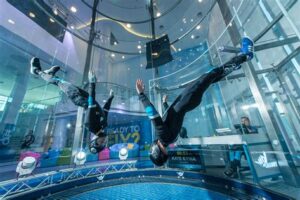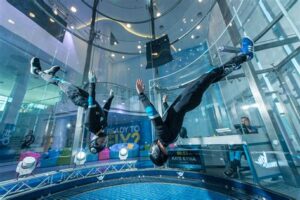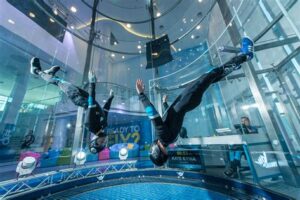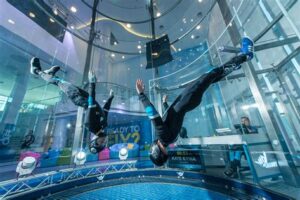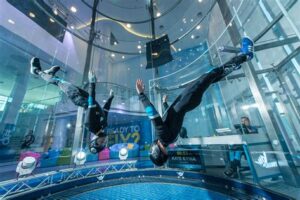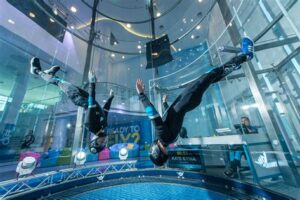Table of Contents
Looking to turn your skydiving dreams into reality? Discover the exhilarating adventure of skydiving and learn how to navigate the skies with our step-by-step guide. From understanding body positioning to mastering the art of steering, this comprehensive tutorial will equip you with the necessary skills to make controlled turns during your skydiving experience. Soar through the clouds and take control of your flight trajectory by following our expert tips and techniques. Begin your journey towards becoming a skilled skydiver today!
Skydiving, an exhilarating and adrenaline-pumping adventure, offers an unparalleled experience of soaring through the sky like a bird. Whether you are a thrill-seeker or simply seeking a new and unique challenge, learning how to turn during a skydive can further elevate your skills and bring an added element of excitement to your dives. By mastering the art of turning, you can effortlessly change your direction mid-air, adding twists and turns to your descent that will leave you breathless and craving for more. So, if you are ready to take your skydiving skills to new heights, let’s delve into the techniques and strategies that will help you execute flawless turns with precision and grace.
Introduction
Skydiving is an exhilarating activity that allows individuals to experience the thrill of freefalling through the sky. For those who are passionate about this sport, turning while in mid-air adds another level of excitement and skill to their skydiving repertoire. Mastering the art of turning during a skydive requires proper technique, focus, and practice. In this article, we will guide you through the steps on how to turn while skydiving.
Understanding Body Position
Before attempting any turns during a skydive, it is crucial to have a solid understanding of body position. Maintaining a stable and balanced body posture is essential for safe skydiving and executing turns effectively. It is important to keep your body relaxed, with arms and legs slightly bent and spread apart for stability. This position allows for better control and maneuverability in the air.
Using Your Arms
One of the key elements in successfully turning while skydiving is the use of your arms. By extending one arm out in the direction you want to turn, you can initiate the rotation. The arm acts as a rudder, generating lift and creating a torque force that helps you change your heading. It is important to keep your movements smooth and controlled to maintain stability throughout the turn.
Shifting Your Weight
In addition to using your arms, shifting your weight is another technique that aids in turning while skydiving. By shifting your hips and legs in the desired direction, you can create a slight imbalance, causing your body to rotate. This movement should be subtle and coordinated with your arm extension to achieve a smooth and controlled turn. Remember to keep your body relaxed and avoid any sudden or jerky motions.
Visualizing Your Turn
Before attempting any turns during a skydive, it is essential to visualize the maneuver in your mind. Visualization helps prepare your body and mind for the action, allowing you to anticipate the movements required. By mentally rehearsing the turn, you can improve your coordination and timing, making the execution smoother and more efficient.
Timing and Coordination
Timing and coordination are crucial when executing turns while skydiving. It is important to initiate the turn at the right moment to ensure stability and control throughout the maneuver. Coordinate your arm extension and weight shift simultaneously, creating a seamless transition. Practice and experience will help you refine your timing and coordination skills over time.
Monitoring Altitude and Speed
When performing turns during a skydive, it is essential to constantly monitor your altitude and speed. Losing track of these factors can compromise your safety and the success of your turns. Maintain awareness of your altitude to ensure you have enough time to complete the turn and deploy your parachute safely. Additionally, be mindful of your speed, as excessive velocity can make controlling the turn more challenging.
Practicing in Controlled Environments
Before attempting complex turns during a skydive, it is recommended to practice in controlled environments such as wind tunnels or indoor skydiving facilities. These environments allow you to refine your technique, body positioning, and coordination without the added risks of an actual skydive. Regular practice will enhance your skills and confidence, preparing you for more advanced maneuvers in the sky.
Seeking Professional Guidance
Skydiving is an extreme sport that requires proper training and guidance. To learn how to turn while skydiving safely and effectively, it is highly recommended to seek professional instruction. Certified skydiving instructors can provide valuable insights, personalized feedback, and help you develop the necessary skills to execute turns with confidence.
Conclusion
Turning while skydiving adds an exciting dimension to an already thrilling sport. By understanding body position, utilizing your arms and weight shifts, visualizing the maneuver, practicing in controlled environments, and seeking professional guidance, you can master the art of turning during a skydive. Remember, safety should always be the top priority, so ensure you have the necessary skills and experience before attempting complex maneuvers in the sky.
How to Turn Skydiving into a Professional Endeavor
Skydiving is not just an exhilarating adventure sport; it can also be a viable professional endeavor for those with the right skills, training, and dedication. To turn skydiving into a professional career, it is crucial to follow a series of steps that will enhance your expertise, reputation, and opportunities within the industry. This article will outline the key factors to consider when transforming skydiving into a professional pursuit.
The Importance of Professional Training and Certification
Obtaining professional training and certification is the first and most crucial step when embarking on a career in skydiving. These certifications not only enhance your skillset but also ensure that you have the necessary knowledge of safety procedures and protocols to navigate any potential risks. It is essential to invest time and effort into acquiring certifications from reputable associations such as the United States Parachute Association (USPA) or the International Bodyflight Association (IBA). These certifications will help establish yourself as a professional in the field and provide credibility to potential employers or clients.
Building a Strong Physical Fitness Routine
Maintaining a strong physical fitness routine is paramount for any professional skydiver. Engaging in regular cardiovascular exercises, strength training, and flexibility activities will help you maximize your performance and reduce the risk of injury during skydives. Incorporate activities like running, weightlifting, yoga, and stretching into your regimen to enhance your overall fitness levels. A well-conditioned body will enable you to handle the physical demands of skydiving and perform at your best.
Developing Advanced Skydiving Skills
To excel in the professional skydiving arena, it is crucial to go beyond basic skydiving skills and expand your knowledge and capability in advanced techniques and maneuvers. Consider enrolling in specialized training programs or seeking mentorship from experienced skydivers who can help you master techniques such as freefall acrobatics, formation skydiving, or canopy piloting. Continuously practicing and refining these skills will set you apart as a professional skydiver and open doors to more challenging and exciting opportunities.
Networking Within the Skydiving Community
Developing strong connections within the skydiving community can significantly impact your professional growth. Attend events, such as skydiving competitions or conventions, and engage with fellow skydivers, coaches, and industry professionals. Networking can lead to potential sponsorships, job offers, and collaborations, providing you with exposure in the skydiving industry. Building a supportive network of like-minded individuals will not only enhance your professional opportunities but also foster a sense of community and shared passion for the sport.
Gaining Experience Through Competitive Skydiving
Participating in competitive skydiving can be a valuable avenue to gain exposure and build a professional reputation. Take part in local, regional, or national skydiving competitions to showcase your skills, challenge yourself, and gain recognition within the community. The experience gained through competitions can open doors to sponsorships, endorsements, and even coaching opportunities. Additionally, competing allows you to measure your skills against other professionals, providing valuable feedback and areas for improvement.
Acquiring Additional Qualifications and Licenses
Besides obtaining basic skydiving certifications, consider acquiring additional qualifications and licenses that can contribute to your professional growth. This could include becoming a tandem instructor, a camera flyer, or obtaining pilot licenses for flying jump planes. Expanding your skillset and versatility can provide you with diverse professional opportunities within the skydiving industry. By becoming proficient in different roles, you can increase your employability and adaptability to various skydiving environments.
Promoting Yourself and Creating a Professional Brand
To succeed as a professional skydiver, it is essential to market yourself effectively and create a professional brand. Develop a strong online presence through a well-designed website, active social media profiles, and a professional portfolio showcasing your achievements and skills. Collaborate with photographers and videographers to capture high-quality footage of your dives, and use this content to promote your professional image. Regularly update your online platforms with engaging content that reflects your expertise and passion for skydiving.
Seeking Professional Sponsorships and Endorsements
Establishing partnerships with equipment manufacturers, skydiving gear companies, or other sponsors can provide financial support and recognition in your professional skydiving career. Reach out to potential sponsors, highlighting your achievements, skills, and dedication to the sport. Proving your worth as a professional skydiver and brand ambassador can lead to opportunities for sponsorships, endorsements, and even equipment discounts. Create a compelling sponsorship proposal that showcases the mutual benefits of partnering with you, and actively seek out collaborations that align with your professional goals and values.
In conclusion, turning skydiving into a professional endeavor requires a combination of professional training, physical fitness, advanced skills, networking, experience, additional qualifications, self-promotion, and seeking sponsorships. By investing time and effort into each of these areas, you can establish yourself as a professional skydiver and unlock exciting opportunities within the industry.
As a professional skydiving instructor, I believe that turning skydiving into a truly thrilling and safe experience requires a certain level of expertise and adherence to professional standards. Here are some key points to consider:
1. Safety First:
- Always prioritize safety by ensuring that all necessary equipment is properly inspected, maintained, and in good working condition.
- Maintain a strict adherence to safety protocols, including thorough pre-jump training and consistent communication with the divers.
- Regularly update your knowledge and skills through continuous training and staying up-to-date with the latest industry standards.
2. Professionalism:
- Present yourself in a professional manner, both in appearance and behavior, to instill confidence in your clients.
- Exhibit strong communication skills by providing clear instructions, answering questions, and addressing any concerns to ensure a smooth and enjoyable experience.
- Show respect towards your fellow skydivers, colleagues, and the environment by following local regulations and guidelines.
3. Customer Experience:
- Strive to create a positive and memorable experience for your clients by offering personalized attention and catering to their needs.
- Provide a comprehensive briefing on the entire skydiving process, from the equipment used to the correct body positioning during free fall.
- Share your knowledge about the surrounding landscape and landmarks to enhance the overall experience.
4. Attention to Detail:
- Pay meticulous attention to every aspect of the skydiving operation, from the weather conditions to the aircraft used for the jumps.
- Thoroughly assess each client’s physical fitness and overall health to ensure they are capable of participating in the activity safely.
- Regularly review and update safety procedures to ensure that potential risks are minimized and that all equipment is in peak condition.
5. Constant Improvement:
- Continuously seek opportunities for professional development, such as attending seminars or workshops, to refine your skills and stay ahead in the industry.
- Solicit feedback from clients and colleagues to identify areas for improvement and implement necessary changes to enhance the skydiving experience.
- Stay informed about the latest advancements in skydiving technology and techniques to provide the best possible experience for your clients.
In conclusion, turning skydiving into a professional and exhilarating adventure requires a commitment to safety, professionalism, customer satisfaction, attention to detail, and continuous self-improvement. By adhering to these principles, skydiving instructors can provide an unforgettable experience while ensuring the utmost safety for their clients.
Thank you for visiting our blog on the exhilarating activity of skydiving. We hope that this article has provided you with valuable insights and tips on how to turn while in mid-air. As you embark on your skydiving journey, it is crucial to approach this extreme sport with a professional mindset, always prioritizing safety and adhering to proper techniques. Remember, mastering the art of turning while skydiving requires practice, patience, and a deep understanding of your body’s movements in the air.
First and foremost, it is essential to emphasize that skydiving should only be pursued under the supervision of certified professionals. While the idea of turning freely in the sky may seem thrilling, it is important to learn the basics first. Start by taking a comprehensive training course where experienced instructors will guide you through the fundamentals of skydiving. They will teach you how to maintain balance, control your body position, and execute basic turns before progressing to more advanced maneuvers.
When executing turns in the air, it is crucial to master the technique known as tracking. This involves positioning your body in a way that allows for efficient movement through the air. To initiate a turn, shift your weight slightly towards the direction you want to go. Simultaneously, use your arms and legs to adjust your body’s orientation. This will create drag on the desired side and help you smoothly change directions. Remember to maintain stability throughout the turn by keeping your body aligned and your head up, allowing for better control and awareness of your surroundings.
In conclusion, learning how to turn while skydiving requires dedication and a commitment to continuous improvement. Always prioritize safety by choosing reputable skydiving centers and following the guidance of experienced instructors. By practicing proper techniques, such as mastering the art of tracking and maintaining stability during turns, you can enhance your skydiving skills and experience the thrill of maneuvering through the sky with confidence. So go out there, spread your wings, and enjoy the exhilarating sensation of turning freely in the sky!
Video How To Turn Skydiving
People also ask about how to turn skydiving:
-
How do you turn while skydiving?
Turning while skydiving involves using your body position and manipulating the airflow around you. To turn left, shift your weight slightly to the left and raise your left arm while lowering your right arm. This will help you create drag on the left side of your body, causing you to rotate in that direction. To turn right, simply reverse the process by shifting your weight to the right and adjusting your arm positions accordingly.
-
What is the correct body position for turning during a skydive?
The correct body position for turning during a skydive is to maintain a stable and balanced arch position. This involves keeping your head up, back arched, legs slightly bent, and arms extended to the sides. By maintaining this stable body position, you can effectively control your turns without compromising your stability or safety during the skydive.
-
Are there any risks associated with turning while skydiving?
While turning during a skydive is generally safe, there are some risks involved if not executed properly. Rapid or excessive turns can lead to loss of stability and control, increasing the chances of an unstable descent or a potential collision with other skydivers. It is crucial to receive proper training and practice turning techniques under the guidance of a certified instructor to minimize these risks.
-
Can beginners learn to turn while skydiving?
Yes, beginners can learn to turn while skydiving. However, it is essential for beginners to focus on mastering the basics of skydiving, such as stability and body positioning, before attempting turns. Once a solid foundation is established, beginners can gradually progress to learning turning techniques with the guidance of an experienced instructor.
-
What are some advanced turning techniques in skydiving?
Advanced turning techniques in skydiving include performing more precise and dynamic turns, such as carving turns or tracking turns. These techniques require a higher level of skill and experience as they involve more aggressive body movements and increased speeds. It is crucial to receive thorough training and practice extensively before attempting advanced turning maneuvers.

